Managed Aquifer Recharge in Africa: Taking Stock and Looking Forward
Abstract
1. Introduction
2. Methods
2.1. Case Collation
2.2. Case Classification
3. Results
4. Discussion and Conclusions
5. Looking Forward
Supplementary Materials
Author Contributions
Funding
Acknowledgments
Conflicts of Interest
References
- IPCC. Climate Change 2007—The Physical Science Basis: Working Group I Contribution to the Fourth Assessment Report of the IPCC; Solomon, S., Qin, D., Manning, M., Averyt, K., Marquis, M., Eds.; Cambridge University Press: Cambridge, UK; New York, NY, USA, 2007; Volume 4. [Google Scholar]
- Sadoff, C.W.; Hall, J.W.; Grey, D.; Aerts, J.C.J.H.; Ait-Kadi, M.; Brown, C.; Cox, A.; Dadson, S.; Garrick, D.; Kelman, J.; et al. Securing Water, Sustaining Growth: Report of the GWP/OECD Task Force on Water Security and Sustainable Growth; University of Oxford: Oxford, UK, 2015; p. 180. [Google Scholar]
- African Ministers Council on Water. Water Security and Climate Resilient Development, Strategic Framework; African Ministers Council on Water: Abuja, Nigeria, 2012. [Google Scholar]
- Cobbing, J.; Hiller, B. Waking a sleeping giant: Realizing the potential of groundwater in Sub-Saharan Africa. World Dev. 2019, 122, 597–613. [Google Scholar] [CrossRef]
- Lautze, J.; Holmatov, B.; Saruchera, D.; Villholth, K.G. Conjunctive management of surface and groundwater in transboundary watercourses: A first assessment. Water Policy 2018, 20, 1–20. [Google Scholar] [CrossRef]
- Megdal, S.B.; Dillon, P. Policy and Economics of Managed Aquifer Recharge and Water Banking. Water 2015, 7, 592–598. [Google Scholar] [CrossRef]
- Margat, J.; van der Gun, J. Groundwater around the World: A Geographic Synopsis; CRC Press: Boca Raton, FL, USA, 2013. [Google Scholar]
- Tuinhof, A.; Foster, S.; van Steenbergen, F.; Talbi, A.; Wishart, M. Appropriate Groundwater Management Policy for Sub-Saharan Africa: In Face of Demographic Pressure and Climatic Variability; World Bank: Washington, DC, USA, 2011. [Google Scholar]
- Bouwer, H. Integrated water management: Emerging issues and challenges. Agric. Water Manag. 2000, 45, 217–228. [Google Scholar] [CrossRef]
- Bouwer, H. Artificial recharge of groundwater: Hydrogeology and engineering. Hydrogeol. J. 2002, 10, 121–142. [Google Scholar] [CrossRef]
- Asano, T.; Cotruvo, J.A. Groundwater recharge with reclaimed municipal wastewater: Health and regulatory considerations. Water Res. 2004, 38, 1941–1951. [Google Scholar] [CrossRef]
- Ebrahim, G.Y.; Fathi, S.; Lautze, J.; Ansems, N.; Villholth, K.G.; Nijste, G.-J.; Magombeyi, M.; Mndaweni, S.; Kenabatho, P.; Moehadu, M.; et al. Review of Managed Aquifer Recharge (MAR) Experience in Africa and MAR Suitability Mapping for Ramotswa Transboundary Aquifer Area; International Water Management Institute: Pretoria, South Africa, 2017. [Google Scholar]
- Dillon, P.; Stuyfzand, P.; Grischek, T.; Lluria, M.; Pyne, R.D.G.; Jain, R.C.; Bear, J.; Schwarz, J.; Wang, W.; Fernandez, E.; et al. Sixty years of global progress in managed aquifer recharge. An overview of Managed Aquifer Recharge in Southern Africa. Hydrogeol. J. 2019, 27, 1–30. [Google Scholar] [CrossRef]
- Murray, R. Managed Aquifer Recharge, an Introductory Guide for the SADC Groundwater Management Institute Including the Windhoek Case Study; Groundwater Africa: Cape Town, South Africa, 2017. [Google Scholar]
- Murray, R.; Louw, D.; van der Merwe, B.; Peters, I. Windhoek, Namibia: From conceptualising to operating and expanding a MAR scheme in a fractured quartzite aquifer for the city’s water security. Sustain. Water Resour. Manag. 2018, 4, 217–223. [Google Scholar] [CrossRef]
- Bugan, R.D.; Jovanovic, N.; Israel, S.; Tredoux, G.; Genthe, B.; Steyn, M.; Allpass, D.; Bishop, R.; Marinus, V. Four decades of water recycling in Atlantis (Western Cape, South Africa): Past, present and future. Water SA 2016, 42, 577–594. [Google Scholar] [CrossRef]
- Jovanovic, N.; Bugan, R.D.; Tredoux, G.; Israel, S.; Bishop, R.; Marinus, V. Hydrogeological modelling of the Atlantis aquifer for management support to the Atlantis Water Supply Scheme. Water SA 2017, 43, 122–138. [Google Scholar] [CrossRef]
- DWA. The Atlantis Water Resource Management Scheme: 30 Years of Artificial Groundwater Recharge; PRSA 000/001/1169/10-Activity 17 (AR5.1); Department of Water Affairs: Pretoria, South Africa, 2010.
- Sprenger, C.; Hartog, N.; Hernández, M.; Vilanova, E.; Grützmacher, G.; Scheibler, F.; Hannappel, S. Inventory of managed aquifer recharge sites in Europe: Historical development, current situation and perspectives. Hydrogeol. J. 2017, 25, 1909–1922. [Google Scholar] [CrossRef]
- Valverde, J.P.B.; Stefan, C.; Nava, A.P.; da Silva, E.B.; Vivar, H.L.P. Inventory of managed aquifer recharge schemes in Latin America and the Caribbean. Sustain. Water Resour. Manag. 2018, 4, 163–178. [Google Scholar] [CrossRef]
- Stefan, C.; Ansems, N. Web-based global inventory of managed aquifer recharge applications. Sustain. Water Resour. Manag. 2018, 4, 153–162. [Google Scholar] [CrossRef]
- IGRAC. International Groundwater Resources Assessment Centre (IGRAC) Global MAR Portal. Available online: https://www.un-igrac.org/ggis/mar-portal (accessed on 6 May 2020).
- Wipplinger, O. The Storage of Water in Sand; an Investigation of the Properties of Natural and Artificial Sand Reservoirs and of Methods of Developing such Reservoirs; South West Africa Administration Water Affairs Branch: Windhoek, Namibia, 1958. [Google Scholar]
- Gijsbertsen, C.; Groen, J. A Study to Up-Scaling of the Principle and Sediment (Transport) Processes behind, Sand Storage Dams, Kitui District, Kenya. Master’s Thesis, Vrije Universiteit, Amsterdam, The Netherlands, 2007. [Google Scholar]
- Fourie, F.; Vermaak, N.; Hohne, D.; Murray, R. Authorising MAR projects within the context of South Africa’s National Water Act. In Proceedings of the 9th International Symposium on Managed Aquifer Recharge (ISMAR9), Mexico City, Mexico, 20–24 June 2016. [Google Scholar]
- Murray, R.; Baker, K. Kolomela Mine: Results of the Injection Tests in Groenwaterspruit for Mine Water Disposal, Groundwater Africa, South Africa; Groundwater Africa: Cape Town, South Africa, 2012. [Google Scholar]
- Esterhuyse, C.J. Carnarvon: Report on Artificial Recharge Investigation at Saaipoort, Northern Cape Province Report Prepared by SRK Consulting (South Africa) (Pty) Ltd. for Aurecon South Africa (Pty) Ltd.; SRK Consulting: Cape Town, South Africa, 2019. [Google Scholar]
- Hohne, D. Drought in the Northern Cape Karoo: Lessons learned and options for future use. In Proceedings of the 15th Biennial Ground Water Division Conference, Stellenbosch, South Africa, 14–18 October 2017. [Google Scholar]
- Chaieb, H. Tunisian Experience in Artificial Recharge using Treated Waste Water. In Proceedings of the Regional Conference on Sustainable Integrated Wastewater Treatment and Reuse, Sharm El Sheikh, Egypt, 1–2 December 2014. [Google Scholar]
- Bouri, S.; Dhia, H.B. A thirty-year artificial recharge experiment in a coastal aquifer in an arid zone: The Teboulba aquifer system (Tunisian Sahel). C. R. Geosci. 2010, 342, 60–74. [Google Scholar] [CrossRef]
- Funk, C.C.; Peterson, P.J.; Landsfeld, M.F.; Pedreros, D.H.; Verdin, J.P.; Rowland, J.D.; Romero, B.E.; Husak, G.J.; Michaelsen, J.C.; Verdin, A.P. A quasi-global precipitation time series for drought monitoring. US Geol. Surv. Data Ser. 2014, 832, 1–12. [Google Scholar]
- World Resources Institute. Aqueduct Global Maps 2.1 Data. Available online: https://www.wri.org/resources/data-sets/aqueduct-global-maps-21-data (accessed on 7 June 2018).
- Gassert, F.; Luck, M.; Landis, M.; Reig, P.; Shiao, T. Aqueduct Global Maps 2.1: Constructing Decision-Relevant Global Water Risk Indicators; World Resources Institution: Washington, DC, USA, 2014. [Google Scholar]
- IGRAC; UNESCO-IHP. Transboundary Aquifers of the World. 2015. Available online: http://ihp-wins.unesco.org/layers/geonode:tba_map2015 (accessed on 5 September 2018).
- Hartmann, J.; Moosdorf, N. The new global lithological map database GLiM: A representation of rock properties at the Earth surface. Geochem. Geophys. Geosyst. 2012, 13. [Google Scholar] [CrossRef]
- Shamrukh, M.; Abdel-Wahab, A. Riverbank filtration for sustainable water supply: Application to a large-scale facility on the Nile River. Clean Technol. Environ. Policy 2008, 10, 351–358. [Google Scholar] [CrossRef]
- El Arabi, N. Environmental management of groundwater in Egypt via artificial recharge extending the practice to soil aquifer treatment (SAT). Int. J. Environ. Sustain. 2012, 1, 66–82. [Google Scholar] [CrossRef]
- Tredoux, G.; Van Der Merwe, B.; Peters, I. Artificial recharge of the Windhoek aquifer, Namibia: Water quality considerations. Boletín Geológico Min. 2009, 120, 269–278. [Google Scholar]
- DWA. Water Banking: A Practical Guide to Using Artificial Groundwater Recharge; Department of Water Affairs: Pretoria, South Africa, 2010.
- Mohn, R.; Abdurahman, M.A.; Gardemann, J.; Mathys, W.; Nedaw, D.; Kruse, B.; Herbst, C. Subsurface Micro-Reservoirs for Rural Water Supply in the Ethiopian Highlands, v. Available online: https://www.hb.fh-muenster.de/opus/fhms/volltexte/2012/780/ (accessed on 26 October 2017).
- Murray, R. Prince Albert Municipality. In Groundwater Management and Artificial Recharge Feasibility Study; Groundwater Africa: Cape Town, South Africa, 2007. [Google Scholar]
- Murray, R. Bitou Municipality Groundwater Management and Artificial Recharge Feasibility Study; Groundwater Africa: Cape Town, South Africa, 2007. [Google Scholar]
- Murray, E.; Tredoux, G. Pilot Artificial Recharge Schemes: Testing Sustainable Water Resource Development in Fractured Aquifers; Water Research Commission: Pretoria, South Africa, 2002. [Google Scholar]
- Zammouri, M.; Brini, N.; Horriche, F.J. Assessment of Artificial Recharge Efficiency against Groundwater Stress in the El Khairat Aquifer. In Groundwater and Global Change in the Western Mediterranean Area; Springer: Berlin/Heidelberg, Germany, 2018; pp. 305–312. [Google Scholar]
- Bennani, A.; Lary, J.; Nrhira, A.; Razouki, L.; Bize, J.; Nivault, N. Wastewater treatment of greater Agadir (Morocco): An original solution for protecting the bay of Agadir by using the dune sands. Water Sci. Technol. 1992, 25, 239–245. [Google Scholar] [CrossRef][Green Version]
- Igboekwe, M.U.; Ruth, A. Groundwater recharge through infiltration process: A case study of Umudike, Southeastern Nigeria. J. Water Resour. Prot. 2011, 3, 295. [Google Scholar] [CrossRef]
- Murray, R. Artificial Recharge Lecture Notes. In Artificial Recharge: The Intentional Banking and Treating of Water in Aquifers; Department of Water Affairs and Forestry: Pretoria, South Africa, 2008. [Google Scholar]
- Dillon, P.J.; Pavelic, P. Guidelines on the Quality of Stormwater and Treated Wastewater for Injection into Aquifers for Storage and Reuse; Urban Water Research Association of Australia: Melbourne, Australia, 1996. [Google Scholar]
- Prathapar, S.; Sharma, B.R.; Aggarwal, P.K. Hydro, Hydrogeological Constraints to Managed Aquifer Recharge in the Indo Gangetic Plains; International Water Management Institute: Colombo, Sirlanka, 2012. [Google Scholar]
- Botha, F. Can Man-Made Aquifers Provide a Solution for a Thirsty Mining Industry? In Proceedings of the International Symposium on Managed Aquifer Recharge (ISMAR 7), Abu Dhabi, UAE, 9–13 October 2009. [Google Scholar]
- DWA. Potential Artificial Recharge Areas in South Africa; PRSA 000/00/11609/1—Activity 14 (AR04); Department of Water Affairs: Pretoria, South Africa, 2009.
- Tredoux, G.; Genthe, B.; Steyn, M.; Engelbrecht, J.; Wilsenach, J.; Jovanovic, N. An assessment of the Atlantis artificial recharge water supply scheme (Western Cape, South Africa). WIT Trans. Ecol. Environ. 2009, 127, 403–413. [Google Scholar]
- Bouchaou, L. MAR techniques and examples successfully applied in light of climate change adaptation: Case study in Morocco. In Proceedings of the Conference Presentation—Theme Opportunities for Managed Aquifer Recharge, Amman, Jordan, 11–14 December 2012. [Google Scholar]
- Bouragba, L. Etude de la recharge artificielle des nappes en zone semi-aride (Application au bassin du Souss-Maroc). In Study of Artificial Recharge of Groundwater in Semi-Arid Areas (Application to the Souss-Maroc basin), U.F.R Sciences & Techniques; Université de Franche-Comté École Doctorale Homme, Environnement: Santé, France, 2011. [Google Scholar]
- Choukr-Allah, R.; Ragab, R.; Bouchaou, L.; Barceló, D. The Souss-Massa River Basin, Morocco; Springer: Berlin/Heidelberg, Germany, 2017. [Google Scholar]
- Al-Turbak, A.S. Effectiveness of recharge from a surface reservoir to an underlying unconfined aquifer. In Proceedings of the Vienna Symposium of the Hydrology of Natural and Manmade Lakes, Vienna, Austria, 11–24 August 1991; pp. 191–196. [Google Scholar]
- Ghiglieri, G. WADIS-MAR Project: Water harvesting and Agricultural technique in Dry lands: An integrated and Sustainable model in MAghreb Regions. In Proceedings of the WADIS-MAR: Achievements, Activities, WADIS-MAR final Conference International Workshop on Sustainable water Resources Management in Arid and Semi-Arid Regions, Sassari, Italy, 16 June 2016. [Google Scholar]
- DWA. Potential Artificial Recharge Schemes: Planning for Implementation; Department of Water Affairs: Pretoria, South Africa, 2010.
- Mhamdi, R.; Heilweil, V. A Quantitative Evaluation of the Impacts of Artificial Recharge to the Mornag Aquifer System of Northern Tunisia; Acacia Publications: Phoenix, AZ, USA, 2007; pp. 484–493. [Google Scholar]
- DWS. Water Outlook 2018 Report, Revision 25—Updated 20 May 2018 Produced by Department of Water and Sanitation (DWS) City of Cape Town; Department of Water and Sanitation: Cape Town, South Africa, 2018.
- De Trincheria, J.; Nissen-Petersen, E.; Walter, L.F.; Otterphol, R. Factors affecting the performance and cost-efficiency of sand storage dams in South-Eastern Kenya. In Proceedings of the 36th IAHR World Congress, Hague, The Netherlands, 28 June–3 July 2015. [Google Scholar]
- Borst, L.; De Haas, S. Hydrology of Sand Storage Dams: A Case Study in the Kiindu Catchment, Kitui District, Kenya; VU University Amsterdam: Amsterdam, The Netherlands, 2006. [Google Scholar]
- El-Fakharany, Z. Environmental Impact Assessment of Artificial Recharge of Treated Wastewater on Groundwater Aquifer System Case study Abu-Rawash, Egypt. J. Am. Sci. 2013, 9, 309–315. [Google Scholar]
- Botha, F.; Maleka, L. Results show that man-made aquifers within the platinum mining industry in South Africa can provide a solution for future water demands. In Proceedings of the International Mine Water Conference, Aachen, Germany, 4–11 September 2011. [Google Scholar]
- Page, D.; Dillon, P.; Vanderzalm, J.; Bekele, E.; Barry, K.; Miotlinski, K.; Levett, K. Managed Aquifer Recharge Case Study Risk Assessments; Water for a Healthy Country National Research Flagship Report Series ISSN: 1835-095X; CSIRO: Canberra, Australia, 2010. [Google Scholar]
- NRMMC-EPHC-NHMRC. National Water Quality Management Strategy Document No 24. In Australian Guideline for Water Recycling Managing Health and Environmental Risks (Phase 2), Managed Aquifer Recharge Natural Resource; Biotext: Canberra, Australia, 2009. [Google Scholar]
- RAIN. A Practical Guide to Sand Dam Implementation Water Supply through Local Structures as Adaptation to Climate Change; RAIN Foundation: Amsterdam, The Netherlands, 2008. [Google Scholar]
- Demenge, J.; Alba, R.; Welle, K.; Manjur, K.; Addisu, A.; Mehta, L.; Woldearegay, K. Multifunctional roads: The potential effects of combined roads and water harvesting infrastructure on livelihoods and poverty in Ethiopia. J. Infrastruct. Dev. 2015, 7, 165–180. [Google Scholar] [CrossRef]
- Puertas, D.G.-L.; Woldearegay, K.; Mehta, L.; Beusekom, M.; Agujetas, M.; Van Steenbergen, F. Roads for water: The unused potential. Waterlines 2014, 33, 120–138. [Google Scholar] [CrossRef]
- Van Steenbergen, F.; Haile, A.M.; Alemehayu, T.; Alamirew, T.; Geleta, Y. Status and potential of spate irrigation in Ethiopia. Water Resour. Manag. 2011, 25, 1899–1913. [Google Scholar] [CrossRef]
- Boers, T.M.; Ben-Asher, J. A review of rainwater harvesting. Agric. Water Manag. 1982, 5, 145–158. [Google Scholar] [CrossRef]
- Helmreich, B.; Horn, H. Opportunities in rainwater harvesting. Desalination 2009, 248, 118–124. [Google Scholar] [CrossRef]
- Pandey, D.N.; Gupta, A.K.; Anderson, D.M. Rainwater harvesting as an adaptation to climate change. Curr. Sci. 2003, 85, 46–59. [Google Scholar]
- Woldearegay, K.; van Steenbergen, F.; Alemayehu, T.; Manjur, K.; Perez, M.A. The Beneficial Use of Road Water for Climate Resilience and Asset Management. In Proceedings of the 2nd IRF Africa Regional Congress, Windhoek, Namibia, 11–13 July 2017. [Google Scholar]
- DWA. A Check-List for Implementing Successful Artificial Recharge Projects; PRSA 000/00/11609/2—Activity 12 (AR02); Department of Water Affairs: Pretoria, South Africa, 2009.
- WorldPop (School of Geography and Environmental Science, University of Southampton; Department of Geography and Geosciences, University of Louisville; Departement de Geographie, Universite de Namur) and Center for International Earth Science Information Network (CIESIN), Columbia University (2018). Global High Resolution Population Denominators Project—Funded by The Bill and Melinda Gates Foundation (OPP1134076). 2020. Available online: https://dx.doi.org/10.5258/SOTON/WP00647 (accessed on 8 June 2020).
- Martin, R. Clogging Issues Associated with Managed Aquifer Recharge Methods; IAH Commission on Managing Aquifer Recharge: Australia, 2013. Available online: https://recharge.iah.org/files/2015/03/Clogging_Monograph.pdf (accessed on 8 June 2020).
- Hanson, G.; Nilsson, Å. Ground-Water Dams for Rural-Water Supplies in Developing Countries. Groundwater 1986, 24, 497–506. [Google Scholar] [CrossRef]
- Gale, I. Strategies for Managed Aquifer Recharge (MAR) in Semi-Arid Areas; UNESCO IHP: Paris, France, 2005. [Google Scholar]
- Foster, S.; Tuinhof, A. Subsurface Dams to Augment Groundwater Storage in Basement Terrain for Human Subsistence-Brazilian and Kenyan Experience. World Bank Groundw. Manag. Advis. Team 2004, 5, 78–92. [Google Scholar]
- Sobowale, A.; Ramalan, A.; Mudiare, O.; Oyebode, M. Groundwater recharge studies in irrigated lands in Nigeria: Implications for basin sustainability. Sustain. Water Qual. Ecol. 2014, 3, 124–132. [Google Scholar] [CrossRef]
- Department of Water Affairs. Artificial Recharge Strategy Version 2; 2010 November. Available online: http://www.artificialrecharge.co.za/strategydocument/ARTIFICIAL_RECHARGE_STRATEGY_Ver_2_071210_update_010211_1.pdf (accessed on 8 June 2020).
- Bachtouli, S.; Comte, J.-C. Regional-Scale Analysis of the Effect of Managed Aquifer Recharge on Saltwater Intrusion in Irrigated Coastal Aquifers: Long-Term Groundwater Observations and Model Simulations in NE Tunisia. J. Coast. Res. 2019, 35, 91–109. [Google Scholar]
- Chaieb, H.; Moncef, R.; Ouerfelli, N.; Laghi, M.; Magagnini, L.; Tosatto, O.; De Angelis, A.; Sollazzo, F.; Teatini, P. On the effectiveness of reusing treated wastewater by infiltration ponds in coastal farmlands. Preliminary investigation on insights from the Korba site, Tunisia. In Proceedings of the 1st CIGR Inter-Regional Conference on Land and Water Challenges, Bari, Italy, 10−14 Septemebr 2013. [Google Scholar]
- Ouelhazi, H.; Lachaal, F.; Charef, A.; Challouf, B.; Chaieb, H.; Horriche, F.J. Hydrogeological investigation of groundwater artificial recharge by treated wastewater in semi-arid regions: Korba aquifer (Cap-Bon Tunisia). Arab. J. Geosci. 2014, 7, 4407–4421. [Google Scholar] [CrossRef]
- Rekaya, M.; Bedmar, A.P. The Tunisian Experience in Ground Water Artificial Recharge by Treated Wastewater. In Proceedings of the Artificial Recharge of Ground Water, Anaheim, CA, USA, 23–27 August 1988; pp. 612–627. [Google Scholar]
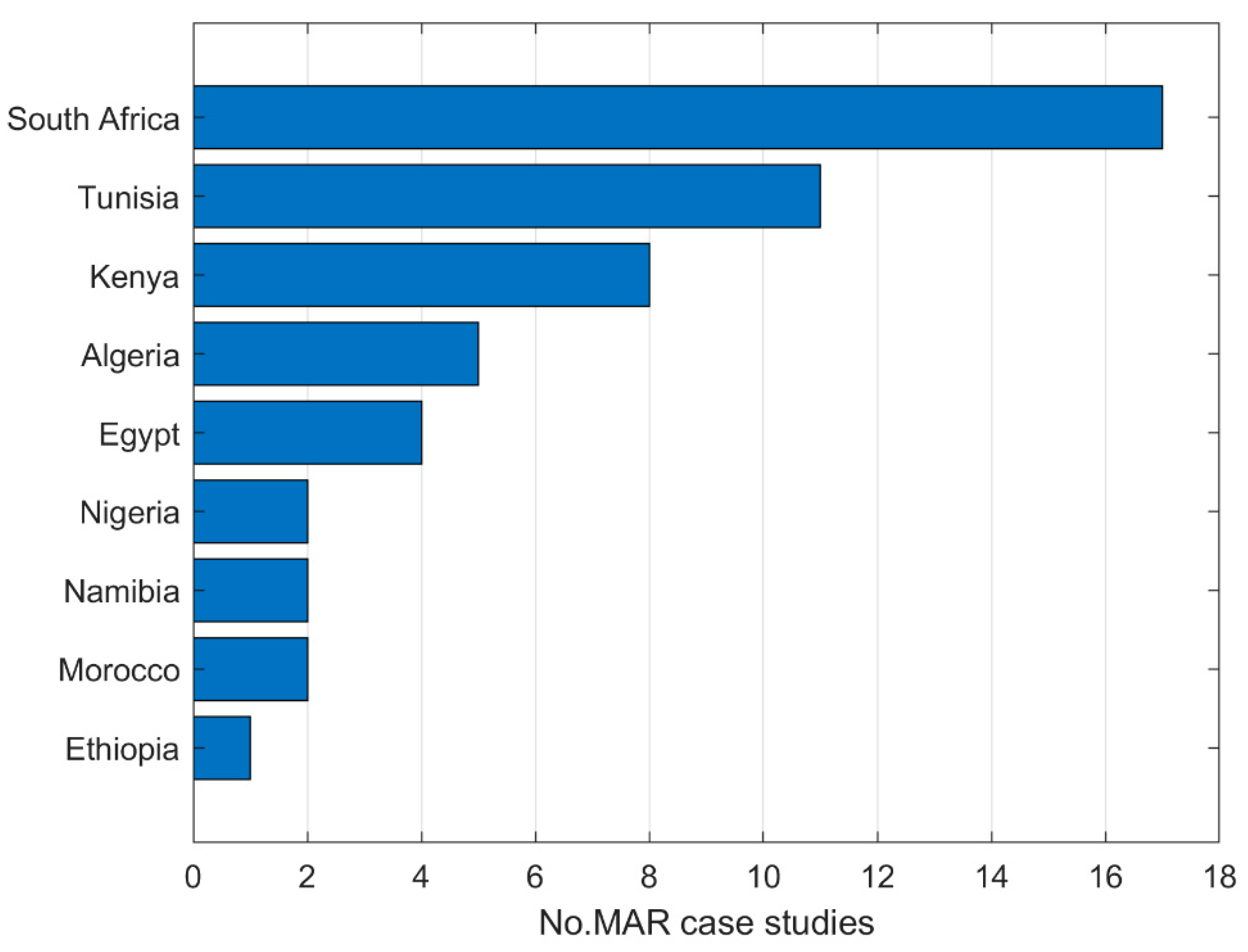
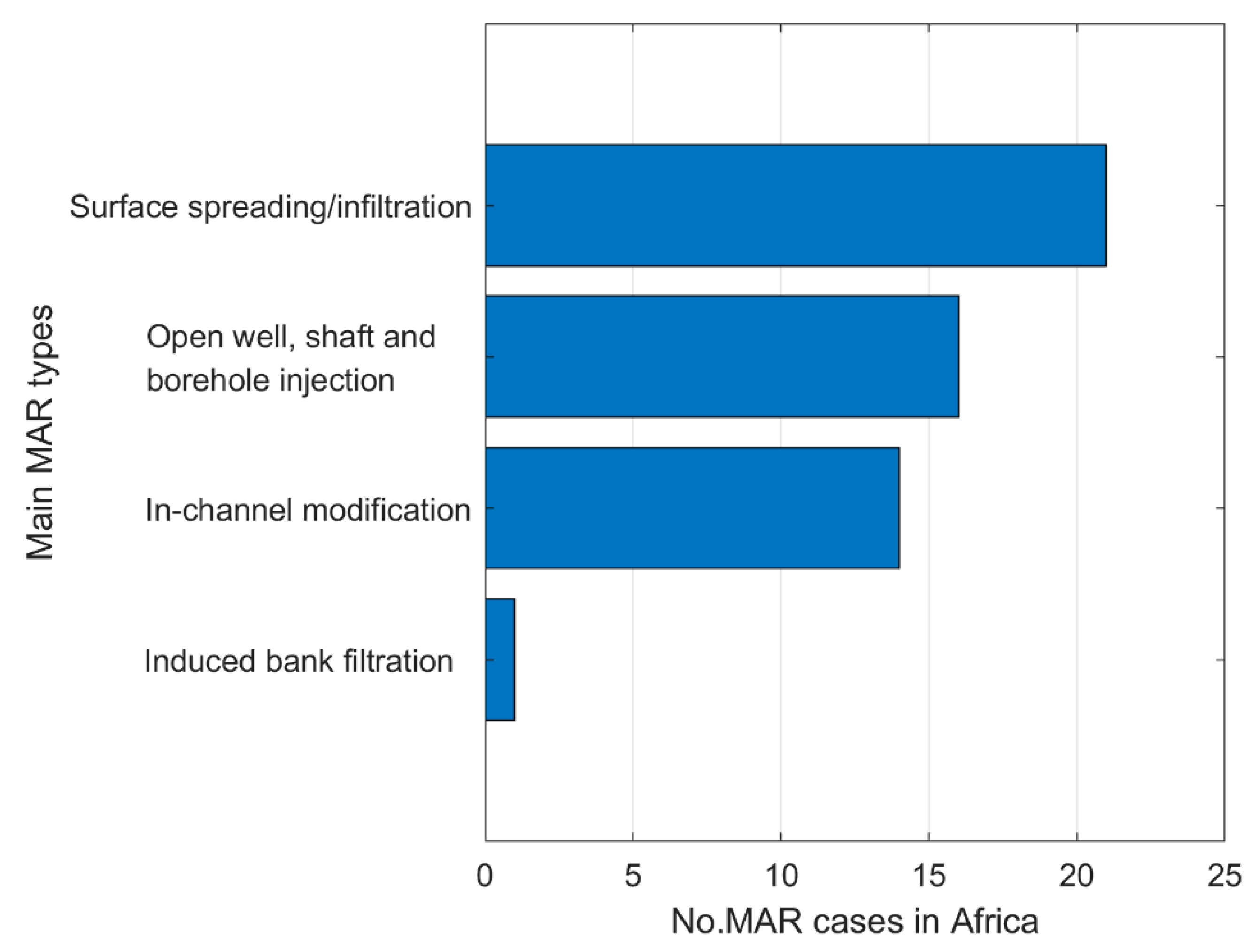
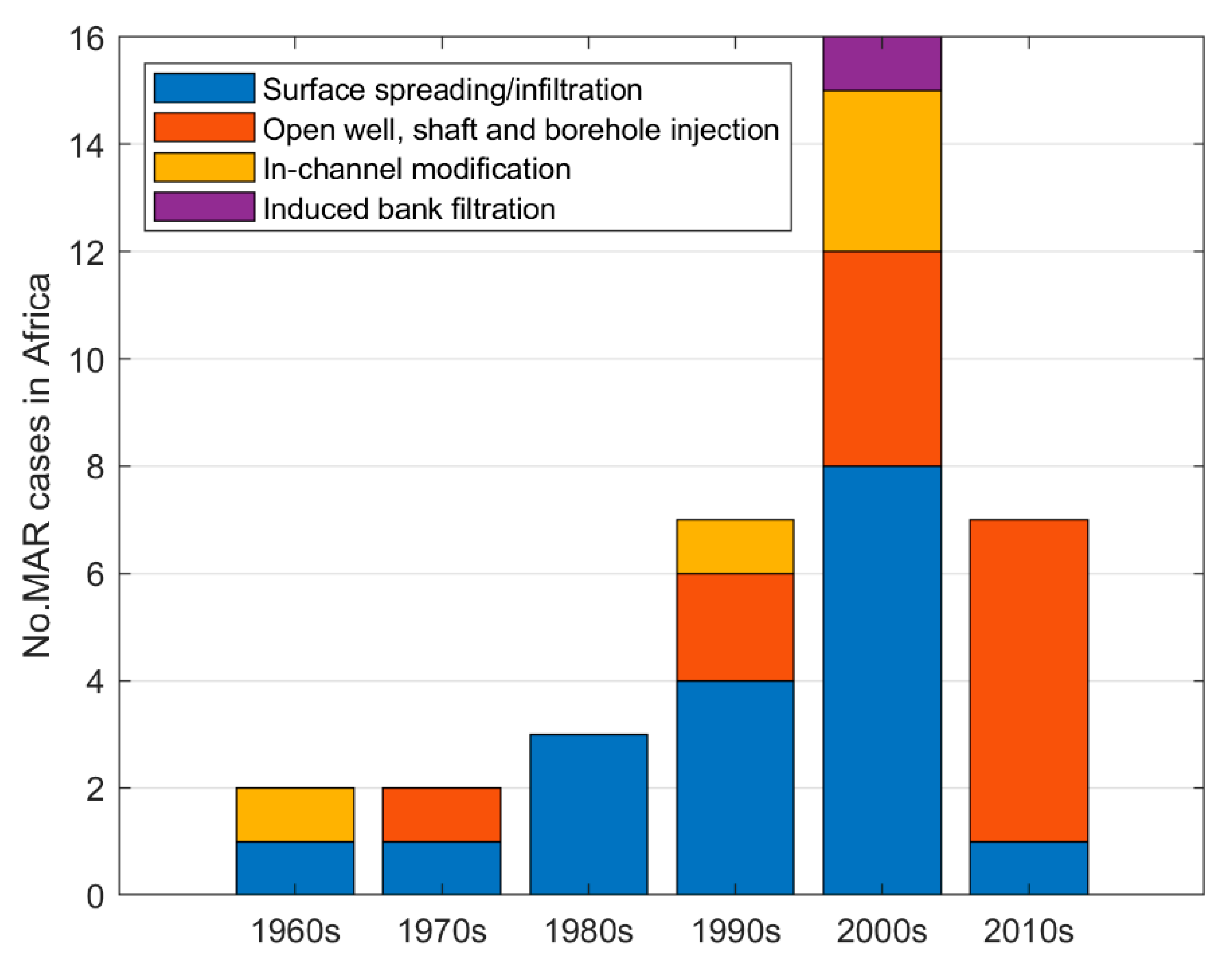
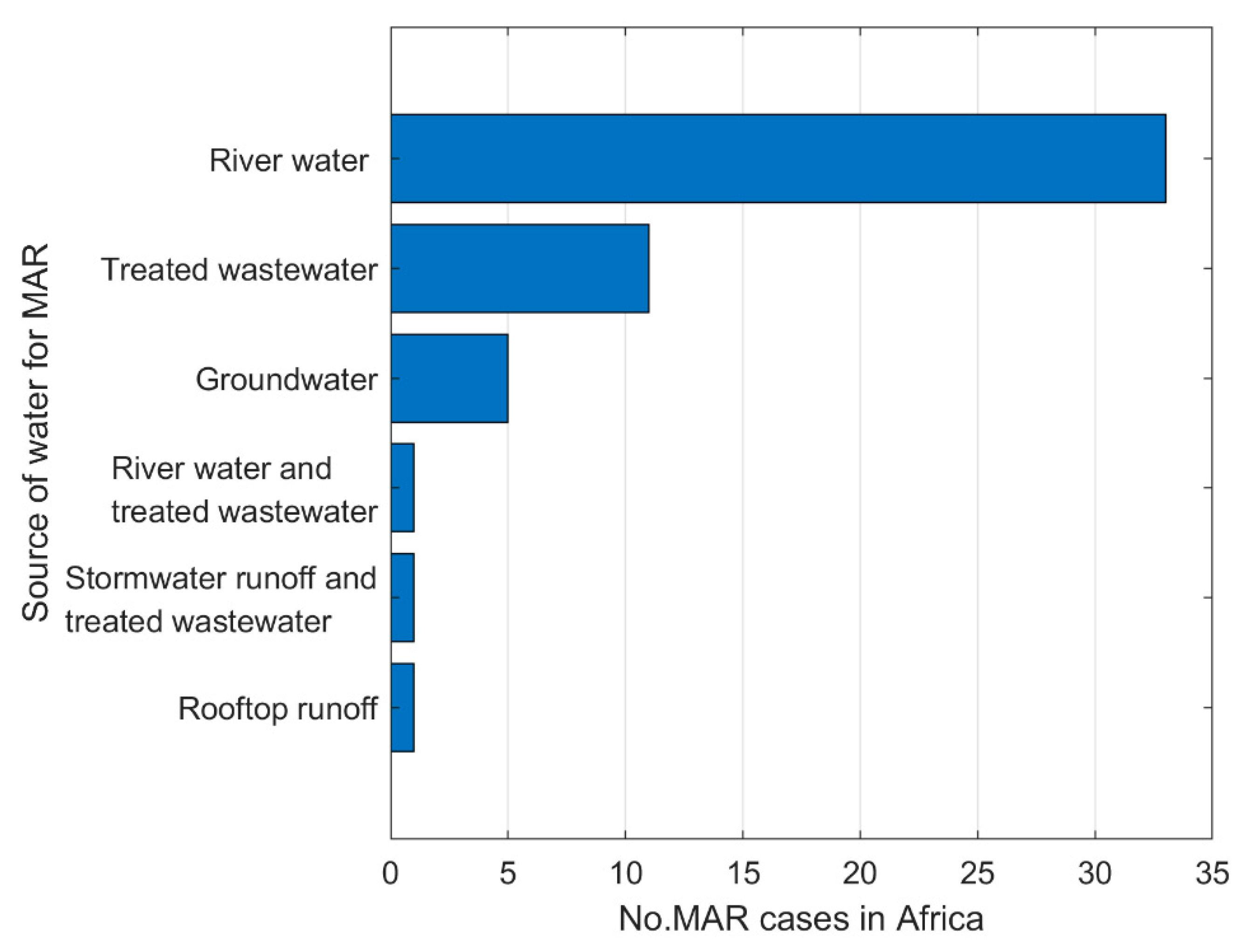

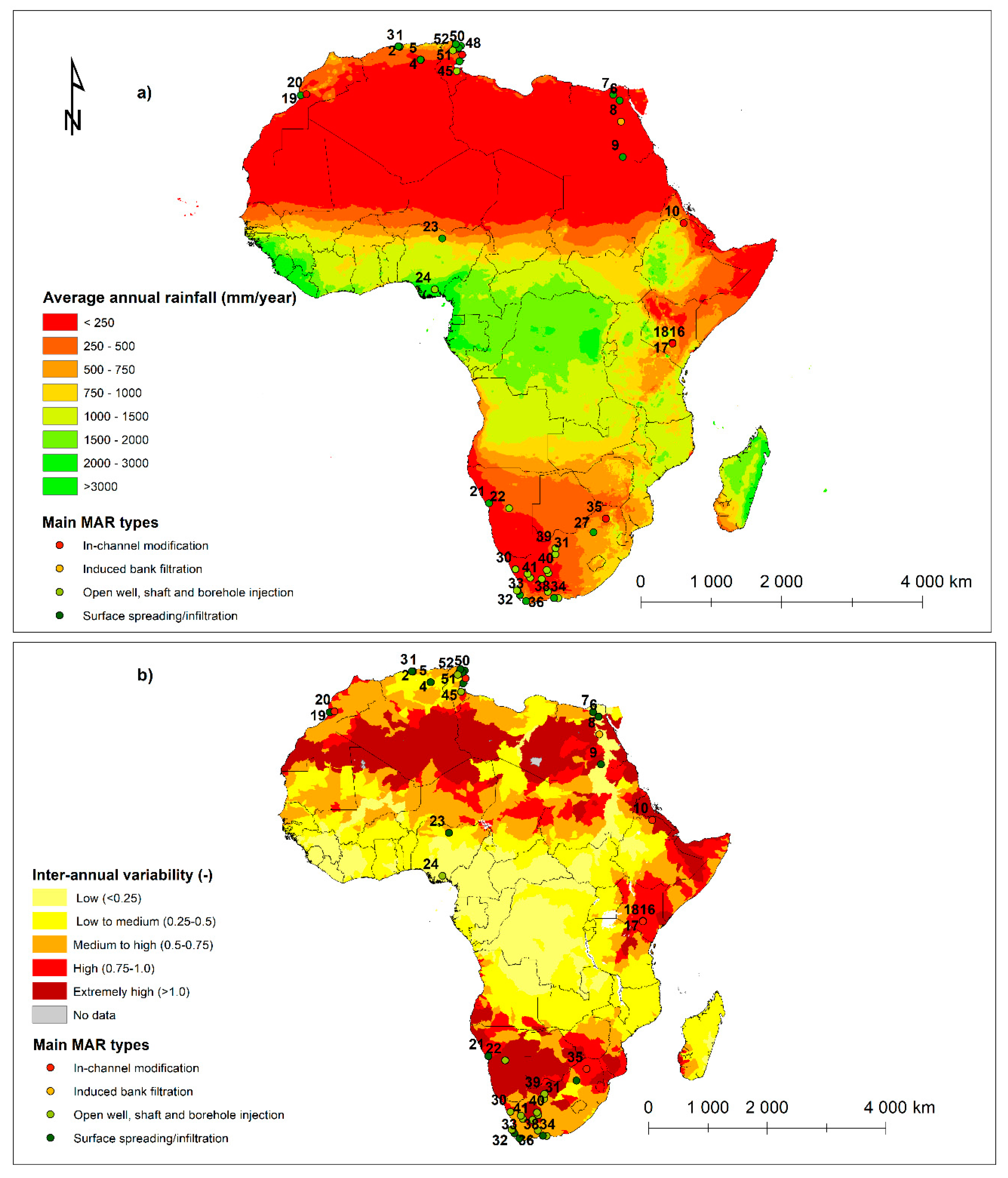
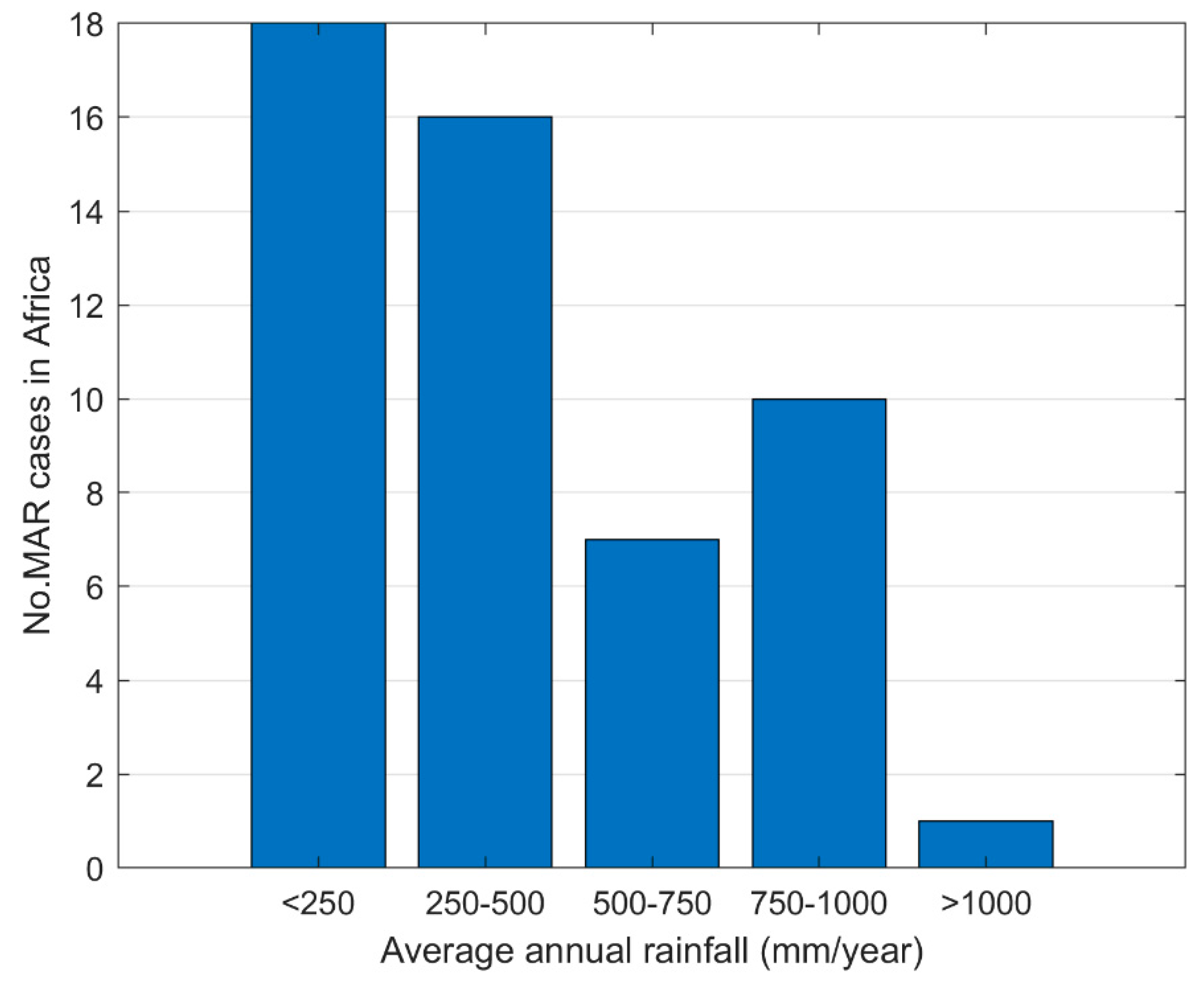
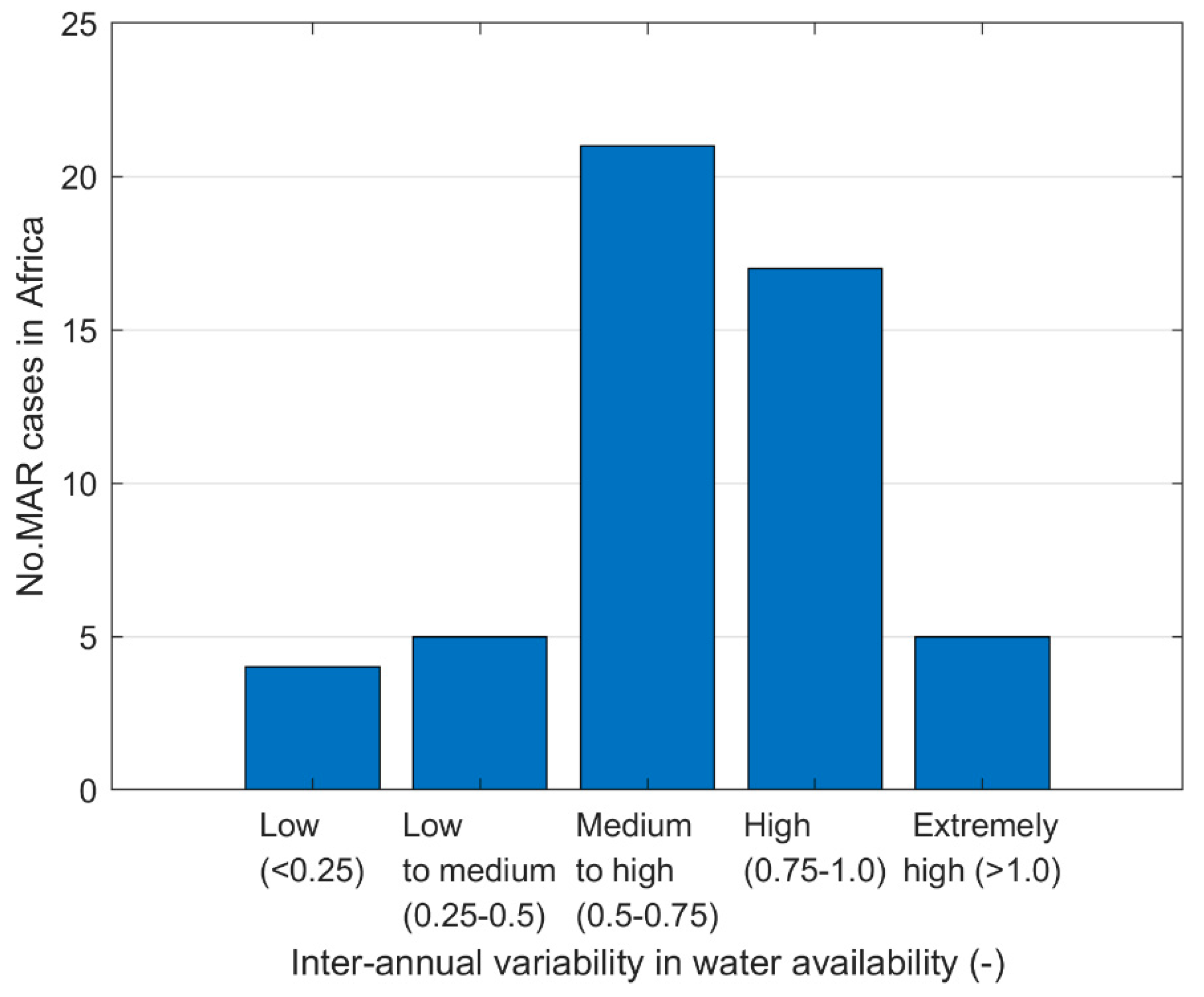
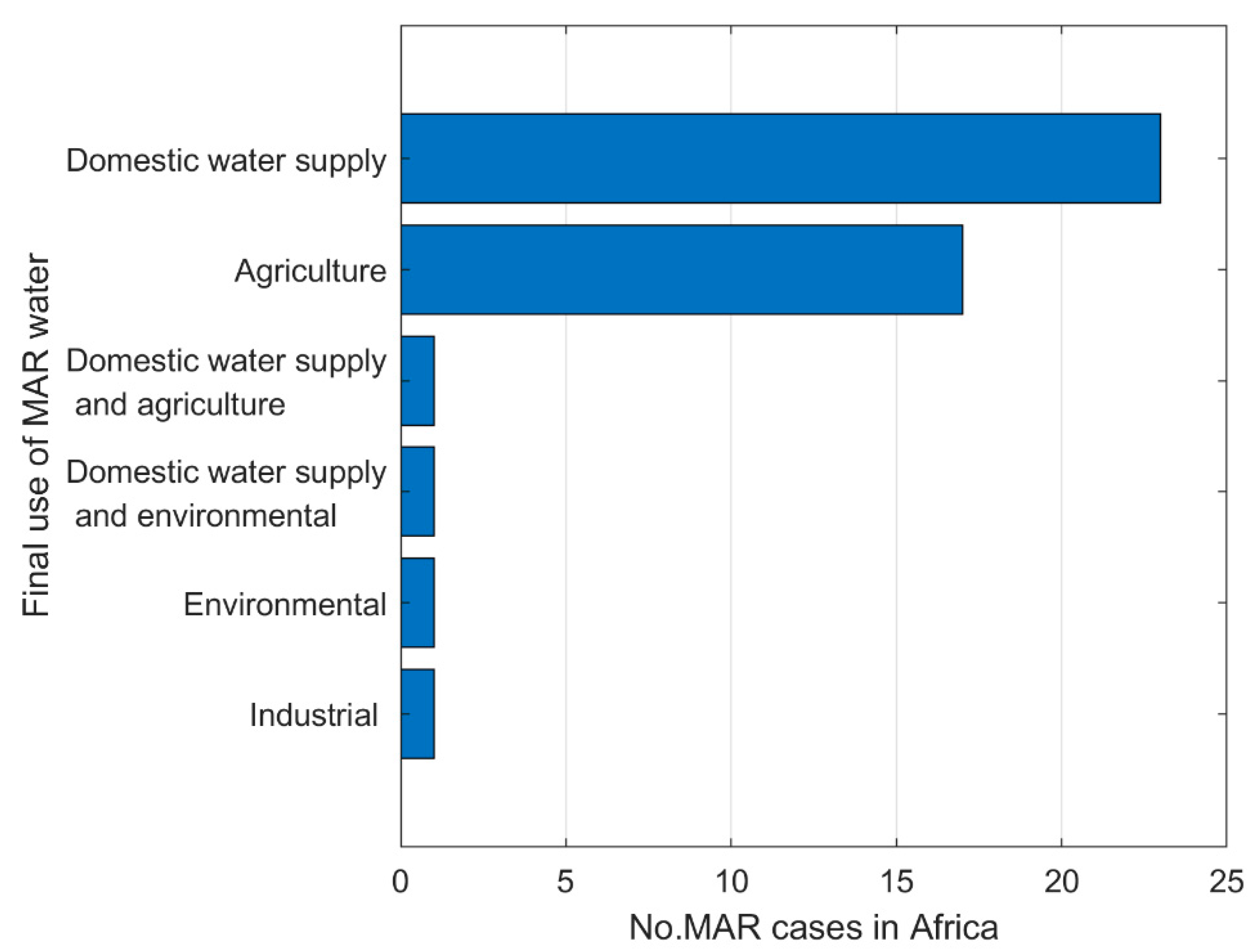
| Parameter | Explanation | Source |
|---|---|---|
| Location | Country and geographic coordinates | [13,22,25,26,27,28,29,30] |
| Start year | Year in which MAR scheme was put in operation | [13,22,25,26,27,28,29,30] |
| Main MAR type | Surface spreading/infiltration; open well, shaft and borehole injection; in-channel modification; rainwater and runoff harvesting and induced bank filtration | [13,22,25,26,27,28,29,30] |
| Source of water | River water, treated wastewater, multiple sources (e.g., river water and treated wastewater, stormwater runoff and treated wastewater), groundwater, and rooftop runoff | [13,22,25,26,27,28,29,30] |
| Key MAR objective |
| Reviewed cases |
| Recharge volume | Volume of water recharged through MAR per year | Reviewed cases |
| Final use (sector) | Domestic water supply, agricultural use, industrial use, environmental use | [13,22,25,26,27,28,29,30] |
| Challenges | Challenges related to technical, bio-physical, and managerial issues e.g., site selection and design, operation and maintenance | Reviewed cases |
| Rainfall | Long-term average annual rainfall in the area of the MAR site | [31] |
| Inter-annual variability of water availability | Calculated as the standard deviation of available “blue” water divided by the mean. The available “blue” water approximates naturalized river discharge. It is an estimate of surface water availability after deducting water consumed upstream. | [32,33] |
| Location in transboundary aquifer | Whether the MAR scheme is located in an identified transboundary aquifer or not | [34] |
| Geology | Geology determined from global geology map and classified into two major rock types: sedimentary and hard rocks | [35] |
| Country | Surface Spreading/Infiltration | Open Well, Shaft and Borehole Injection | In-Channel Modification | Induced Bank Filtration |
|---|---|---|---|---|
| Algeria | 5 | |||
| Egypt | 3 | - | - | 1 |
| Ethiopia | - | - | 1 | - |
| Kenya | - | - | 8 | - |
| Morocco | 1 | - | 1 | - |
| Namibia | 1 | 1 | ||
| Nigeria | 1 | 1 | - | - |
| South Africa | 4 | 12 | 1 | - |
| Tunisia | 6 | 2 | 3 | - |
| Total | 21 | 16 | 14 | 1 |
| MAR Case | Country | Recharge Volume (Mm3/Year) | Reference | |
|---|---|---|---|---|
| Full Scale | Pilot Scale | |||
| Oued Biskra | Algeria | 1.7 | [57] | |
| Sidfa Riverbank Filtration | Egypt | 22.0 | [36] | |
| Koraro-01 | Ethiopia | 0.001 | [40] | |
| Souss-Massa | Morocco | 100 | [53] | |
| Omaruru Delta | Namibia | 9.0 | [47] | |
| Windhoek | Namibia | 2.8 | [13] | |
| Atlantis 1 | South Africa | 4.2 | [13,18] | |
| Calvinia | South Africa | 0.8 | [43] | |
| Elandsfontein 2 | South Africa | 5.6 | [25] | |
| Hermanus | South Africa | 1.5 | [58] | |
| Kharkams | South Africa | 0.005 | [47] | |
| Kolomela | South Africa | 0.7 | [13] | |
| Plettenberg Bay | South Africa | 0.3 | [42] | |
| Polokwane | South Africa | 4.5 | [43] | |
| Sedgefield | South Africa | 0.5 | [58] | |
| Smouskolk (Vanwyksvlei) | South Africa | 1.1 | [25] | |
| Williston | South Africa | 0.1 | [39] | |
| El Hajeb-Sidi Abid | Tunisia | 0.1 | [29] | |
| El Khairat | Tunisia | 3.3 | [29] | |
| Jeffara Plain (Oum Zessar) | Tunisia | 1.2 | [57] | |
| Khalidia | Tunisia | 0.8 | [59] | |
| Korba, Cap Bon | Tunisia | 0.5 | [29] | |
| Teboulba | Tunisia | 0.2 | [30] | |
| Total | 157.8 | 3.1 | ||
| Country | Recharge Volume (Mm3/Year) | Groundwater Use (Mm3/Year) 3 | Recharge Volume as Percentage of Groundwater Use (%) | |
|---|---|---|---|---|
| Full Scale | Pilot Scale | |||
| Morocco | 100 | 3060 | 3.3 | |
| Egypt | 22.0 | 7780 | 0.3 | |
| South Africa | 16.2 | 3.1 | 3140 | 0.5 |
| Namibia | 11.8 | 150 | 7.9 | |
| Tunisia | 6.1 | 2020 | 0.3 | |
| Algeria | 1.7 | 2870 | 0.1 | |
| Ethiopia | 0.001 | 1490 | 0.0 | |
| Kenya | - | 620 | ||
| Nigeria | - | 3440 | ||
| Total | 157.8 | 24,570 | 0.6 | |
© 2020 by the authors. Licensee MDPI, Basel, Switzerland. This article is an open access article distributed under the terms and conditions of the Creative Commons Attribution (CC BY) license (http://creativecommons.org/licenses/by/4.0/).
Share and Cite
Ebrahim, G.Y.; Lautze, J.F.; Villholth, K.G. Managed Aquifer Recharge in Africa: Taking Stock and Looking Forward. Water 2020, 12, 1844. https://doi.org/10.3390/w12071844
Ebrahim GY, Lautze JF, Villholth KG. Managed Aquifer Recharge in Africa: Taking Stock and Looking Forward. Water. 2020; 12(7):1844. https://doi.org/10.3390/w12071844
Chicago/Turabian StyleEbrahim, Girma Y, Jonathan F. Lautze, and Karen G. Villholth. 2020. "Managed Aquifer Recharge in Africa: Taking Stock and Looking Forward" Water 12, no. 7: 1844. https://doi.org/10.3390/w12071844
APA StyleEbrahim, G. Y., Lautze, J. F., & Villholth, K. G. (2020). Managed Aquifer Recharge in Africa: Taking Stock and Looking Forward. Water, 12(7), 1844. https://doi.org/10.3390/w12071844




